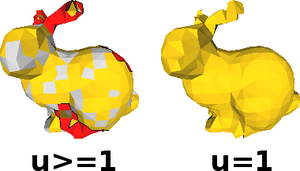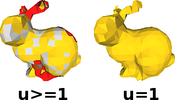Information
- Publication Type: Journal Paper with Conference Talk
- Workgroup(s)/Project(s):
- Date: October 2013
- Journal: Computers & Graphics (Proceedings of Shape Modeling International 2013)
- Volume: 37
- Number: 6
- Location: Bournemouth, UK
- Lecturer: Stefan Ohrhallinger
- ISSN: 0097-8493
- Event: Shape Modeling International 2013 (SMI)
- Conference date: 10. July 2013 – 12. July 2013
- Pages: 645 – 658
- Keywords: point cloud, reconstruction
Abstract
Most methods for interpolating unstructured point clouds handle densely sampled point sets quite well but get into trouble when the point set contains regions with much sparser sampling, a situation often encountered in practice. In this paper, we present a new method that provides a better interpolation of sparsely sampled features. We pose the surface construction problem as finding the triangle mesh which minimizes the sum of all triangles’ longest edge. The output is a closed manifold triangulated surface Bmin. Exact computation of Bmin for sparse sampling is most probably NP-hard, and therefore we introduce suitable heuristics for its computing. The algorithm first connects the points by triangles chosen in order of their longest edge and with the requirement that all edges must have at least 2 incident triangles. This yields a closed non-manifold shape which we call the Boundary Complex. Then we transform it into a manifold triangulation using topological operations. We show that in practice, runtime is linear to that of the Delaunay triangulation of the points.Additional Files and Images
Weblinks
No further information available.BibTeX
@article{ohrhallinger_stefan-2013-smi,
title = "Minimizing Edge Length to Connect Sparsely Sampled
Unorganized Point Sets",
author = "Stefan Ohrhallinger and Sudhir Mudur and Michael Wimmer",
year = "2013",
abstract = "Most methods for interpolating unstructured point clouds
handle densely sampled point sets quite well but get into
trouble when the point set contains regions with much
sparser sampling, a situation often encountered in practice.
In this paper, we present a new method that provides a
better interpolation of sparsely sampled features. We pose
the surface construction problem as finding the triangle
mesh which minimizes the sum of all triangles’ longest
edge. The output is a closed manifold triangulated surface
Bmin. Exact computation of Bmin for sparse sampling is most
probably NP-hard, and therefore we introduce suitable
heuristics for its computing. The algorithm first connects
the points by triangles chosen in order of their longest
edge and with the requirement that all edges must have at
least 2 incident triangles. This yields a closed
non-manifold shape which we call the Boundary Complex. Then
we transform it into a manifold triangulation using
topological operations. We show that in practice, runtime is
linear to that of the Delaunay triangulation of the points.",
month = oct,
journal = "Computers & Graphics (Proceedings of Shape Modeling
International 2013)",
volume = "37",
number = "6",
issn = "0097-8493",
pages = "645--658",
keywords = "point cloud, reconstruction",
URL = "https://www.cg.tuwien.ac.at/research/publications/2013/ohrhallinger_stefan-2013-smi/",
}


 paper
paper slides
slides

